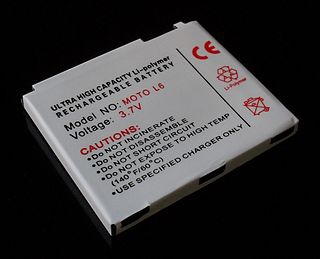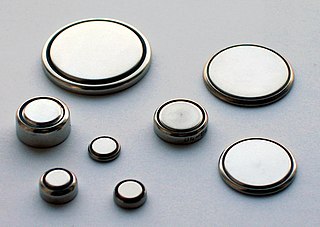
A nickel–metal hydride battery is a type of rechargeable battery. The chemical reaction at the positive electrode is similar to that of the nickel-cadmium cell (NiCd), with both using nickel oxide hydroxide (NiOOH). However, the negative electrodes use a hydrogen-absorbing alloy instead of cadmium. NiMH batteries can have two to three times the capacity of NiCd batteries of the same size, with significantly higher energy density, although only about half that of lithium-ion batteries.

A lithium-ion or Li-ion battery is a type of rechargeable battery that uses the reversible intercalation of Li+ ions into electronically conducting solids to store energy. In comparison with other commercial rechargeable batteries, Li-ion batteries are characterized by higher specific energy, higher energy density, higher energy efficiency, a longer cycle life, and a longer calendar life. Also noteworthy is a dramatic improvement in lithium-ion battery properties after their market introduction in 1991: over the following 30 years, their volumetric energy density increased threefold while their cost dropped tenfold.

A rechargeable battery, storage battery, or secondary cell, is a type of electrical battery which can be charged, discharged into a load, and recharged many times, as opposed to a disposable or primary battery, which is supplied fully charged and discarded after use. It is composed of one or more electrochemical cells. The term "accumulator" is used as it accumulates and stores energy through a reversible electrochemical reaction. Rechargeable batteries are produced in many different shapes and sizes, ranging from button cells to megawatt systems connected to stabilize an electrical distribution network. Several different combinations of electrode materials and electrolytes are used, including lead–acid, zinc–air, nickel–cadmium (NiCd), nickel–metal hydride (NiMH), lithium-ion (Li-ion), lithium iron phosphate (LiFePO4), and lithium-ion polymer.

A lithium polymer battery, or more correctly, lithium-ion polymer battery, is a rechargeable battery of lithium-ion technology using a polymer electrolyte instead of a liquid electrolyte. Highly conductive semisolid (gel) polymers form this electrolyte. These batteries provide higher specific energy than other lithium battery types. They are used in applications where weight is critical, such as mobile devices, radio-controlled aircraft, and some electric vehicles.

The AA battery is a standard size single cell cylindrical dry battery. The IEC 60086 system calls the size R6, and ANSI C18 calls it 15. It is named UM-3 by JIS of Japan. Historically, it is known as D14, U12 – later U7, or HP7 in official documentation in the United Kingdom, or a pen cell.

A battery pack is a set of any number of (preferably) identical batteries or individual battery cells. They may be configured in a series, parallel or a mixture of both to deliver the desired voltage and current. The term battery pack is often used in reference to cordless tools, radio-controlled hobby toys, and battery electric vehicles.

Lithium metal batteries are primary batteries that have metallic lithium as an anode. The name intentionally refers to the metal as to distinguish them from lithium-ion batteries, which use lithiated metal oxides as the cathode material. Although most lithium metal batteries are non-rechargeable, rechargeable lithium metal batteries are also under development. Since 2007, Dangerous Goods Regulations differentiate between lithium metal batteries and lithium-ion batteries.
The Palm m500 series is a series of handheld personal digital assistants that consisted of three devices: the Palm m500, Palm m505, and Palm m515. The series was a follow-up to the Palm V series with a similar, though slightly shorter, footprint and form factor.

A button cell, watch battery, or coin battery is a small battery made of a single electrochemical cell and shaped as a squat cylinder typically 5 to 25 mm in diameter and 1 to 6 mm high – resembling a button. Stainless steel usually forms the bottom body and positive terminal of the cell; insulated from it, the metallic top cap forms the negative terminal.
The lithium-titanate or lithium-titanium-oxide (LTO) battery is a type of rechargeable battery which has the advantage of being faster to charge than other lithium-ion batteries but the disadvantage is a much lower energy density.
Rechargeable lithium metal batteries are secondary lithium metal batteries. They have metallic lithium as a negative electrode. The high specific capacity of lithium metal, very low redox potential and low density make it the ideal negative material for high energy density battery technologies. Rechargeable lithium metal batteries can have a long run time due to the high charge density of lithium. Several companies and many academic research groups are currently researching and developing rechargeable lithium metal batteries as they are considered a leading pathway for development beyond lithium-ion batteries. Some rechargeable lithium metal batteries employ a liquid electrolyte and some employ a solid-state electrolyte.
The lithium–air battery (Li–air) is a metal–air electrochemical cell or battery chemistry that uses oxidation of lithium at the anode and reduction of oxygen at the cathode to induce a current flow.

Johnson Matthey Battery Systems, part of the Johnson Matthey group and formerly called Axeon, designs and manufactures advanced lithium-ion battery systems for electric vehicles and processes over 70 million cells per year. Headquartered in Dundee, Scotland and with operations in Poland and sales offices in Coventry, England, Johnson Matthey Battery Systems produces batteries for all types of electric vehicles including urban delivery vehicles and high performance sports cars.
Aluminium-ion batteries are a class of rechargeable battery in which aluminium ions serve as charge carriers. Aluminium can exchange three electrons per ion. This means that insertion of one Al3+ is equivalent to three Li+ ions. Thus, since the ionic radii of Al3+ (0.54 Å) and Li+ (0.76 Å) are similar, significantly higher numbers of electrons and Al3+ ions can be accepted by cathodes with little damage. Al has 50 times (23.5 megawatt-hours m-3) the energy density of Li and is even higher than coal.
This is a list of commercially-available battery types summarizing some of their characteristics for ready comparison.
The LG G Pro Lite is a smartphone designed and manufactured by LG Electronics. It was announced on October 10, 2019, and became available in November 2018.
Research in lithium-ion batteries has produced many proposed refinements of lithium-ion batteries. Areas of research interest have focused on improving energy density, safety, rate capability, cycle durability, flexibility, and reducing cost.
The Lenovo Z2 Plus is a smartphone manufactured by Lenovo. It is a part of Lenovo's premium smartphone line in 2017, and has two variants. Lenovo Z2 Plus is the Indian version of Lenovo Zuk Z2, that was launched in China in May, 2016.
The Samsung Galaxy A10s is an Android-based smartphone developed and marketed by Samsung Electronics as a part of its Galaxy A series. This phone was announced on August 27, 2019, and was targeted towards the low-budget category. It is the second Galaxy smartphone not manufactured by Samsung and was instead manufactured by Jiaxing Yongrui Electron Technology. Unlike the first ODM Galaxy smartphone, the China-exclusive Samsung Galaxy A6s, it is available internationally.









